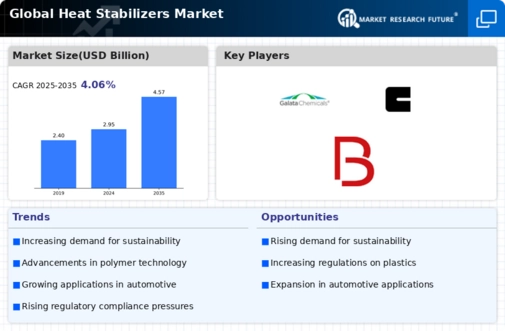Market Share
Heat Stabilizers Market Share Analysis
In the competitive landscape of the Heat Stabilizers market, companies adopt various market share positioning strategies to establish their presence, differentiate their offerings, and gain a competitive edge.
Product differentiation is a primary strategy employed by companies in the Heat Stabilizers market. Manufacturers strive to develop unique formulations, compositions, and functionalities in their stabilizers to stand out among competitors. By offering specialized products that cater to specific industrial needs such as high-temperature resistance, eco-friendliness, or improved performance, companies carve their niche and attract distinct customer segments.
Another essential aspect of market share positioning in the Heat Stabilizers sector is pricing strategies. Some companies focus on cost leadership by offering their products at competitive prices, aiming to capture a larger market share through affordability. Others position themselves as premium brands, emphasizing superior quality or specialized features, thereby justifying higher price points and targeting niche markets willing to pay for added value.
Strategic alliances and collaborations play a significant role in market positioning strategies for Heat Stabilizers. Partnerships with raw material suppliers, research institutions, or even competitors can enable companies to access new technologies, expand their product portfolios, and enhance their market reach. Joint ventures or mergers and acquisitions also offer opportunities to consolidate market share and strengthen competitive positions.
Geographical expansion is another crucial strategy utilized by companies in the Heat Stabilizers market. Expanding into new regions or targeting specific geographical markets allows companies to tap into diverse customer bases, adapt products to local preferences, and mitigate risks associated with market concentration. Moreover, establishing a strong presence in emerging markets with growing industrial sectors can be a strategic move to capitalize on evolving demands.
Customer-centric strategies are pivotal for market share positioning in the Heat Stabilizers sector. Companies focus on understanding customer needs, preferences, and pain points to tailor their products and services accordingly. Providing excellent customer support, technical assistance, and after-sales services can enhance customer loyalty and strengthen a company's position in the market.
Investment in research and development (R&D) is critical for maintaining and improving market share positioning in the Heat Stabilizers industry. Continuous innovation, be it in product formulations, manufacturing processes, or eco-friendly alternatives, allows companies to stay ahead of the curve. R&D investments enable the development of cutting-edge solutions that meet evolving industry standards and regulatory requirements.
Marketing and branding strategies also contribute significantly to market share positioning in the Heat Stabilizers market. Effective branding efforts, targeted advertising campaigns, and a strong online presence help companies communicate their unique value propositions to customers. Building a reputable brand image through effective marketing strategies influences customer perception and contributes to market positioning.
Furthermore, sustainability and environmental consciousness have become integral to market share positioning in the Heat Stabilizers industry. Companies focusing on developing and promoting eco-friendly stabilizers align with the growing consumer preference for sustainable products. Positioning themselves as environmentally responsible brands can attract a segment of customers who prioritize eco-consciousness in their purchasing decisions.
In essence, market share positioning strategies in the Heat Stabilizers industry encompass various approaches, including product differentiation, pricing strategies, strategic alliances, geographical expansion, customer-centric initiatives, R&D investments, branding efforts, and sustainability initiatives. The effective implementation of these strategies enables companies to navigate competition, cater to diverse customer needs, and solidify their positions in the market.







Leave a Comment